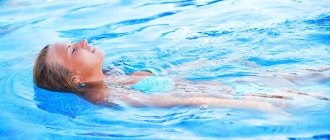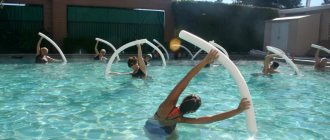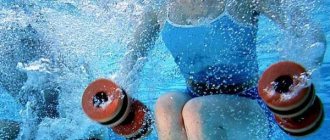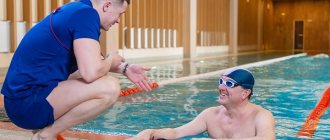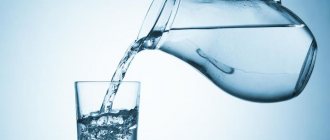How effective is swimming for weight loss and body shaping? This issue remains open for discussion today and is very relevant. There are several points of view and different results of classes.
Some managed to get rid of fat deposits and excess weight in this way, but for others the training did not bring any benefit and did not reduce the numbers on the scales. Why is this happening? What secrets does this sport hold for those who dream of becoming slim? Everything is in order.
Efficiency
First, it’s worth understanding how swimming affects weight loss from a medical point of view. A lot of research has been done on this matter.
Their results are clear: combining this sport with proper nutrition is one of the most effective ways to combat extra pounds and fat deposits on various parts of the body. Moreover, intensive water procedures are more preferable than any other type of physical activity. And that's why:
- depending on your swimming style, you can burn from 200 to 400 calories in half an hour of active exercise;
- if you choose what is better for losing weight: swimming or running, experts say that the first option is preferable, since in this case much more energy is spent - up to 25%;
- double acceleration of metabolism;
- no joint sprains or muscle overloads;
- disappearance of cellulite, which is very important for women suffering from orange peel;
- improved health: the functioning of the lungs and heart is normalized, efficiency increases, blood pressure stabilizes, and nervous tension decreases;
- The massaging effect of water (the so-called natural hydromassage) forms a slim, flexible, sculpted figure, as it not only burns calories, but also works out almost all muscle groups.
If you are planning to lose weight, numerous studies suggest that active and regular swimming in the pool will effectively help you achieve this. This means that if someone failed to lose weight in this way, they simply did not follow the recommendations of aqua fitness instructors and nutritionists, and may not have taken into account some of the nuances of such exercises.
Indeed, it only takes a week to go to the pool to appreciate all its benefits in the fight against excess weight.
According to research. Even just staying on the surface of the water (swimming is not necessary) can burn about 300 calories per hour.
Advantages
If you still doubt whether swimming is good for losing weight, the list of its undeniable advantages in this matter will convince you that you can become slim and fit with it. This type of physical activity is highly recommended for overweight women for several reasons:
- swimming is a minor load on the musculoskeletal system, so many kilograms are not a hindrance for this sport;
- water creates a “hydraulic weightlessness” effect, which allows you to perform even the most difficult exercises without feeling tired and without serious stress on the muscles, which is still happening;
- swimming is suitable for weight loss for any category of citizens: teenagers and pensioners, athletes and even the disabled;
- an additional and very pleasant bonus of this method of losing weight is natural hydromassage, which eliminates cellulite and orange peel;
- active burning of calories.
So swimming as a way to lose weight is an excellent option for overweight people who, for some reason, are not suitable for training in the gym or playing another sport.
And yet, not everyone manages to get rid of extra pounds by visiting the pool. The thing is that if you just come to the pool to swim from time to time, without any set of exercises and programs, without the support of a trainer and a proper nutrition plan, nothing will work out. Like any medal, there is a downside - disadvantages.
Interesting fact. If we compare swimmers with other athletes, among them there are 2 times fewer of those who suffer from hypertension.
Infant swimming
arguments for
Immediately after birth, the child moves from the aquatic environment to the air environment, where he begins to breathe independently. But for some time after birth, the child retains the breath-holding reflex, and he can even sometimes swim and breathe correctly at the same time. Many infant swimming techniques are based on this, especially the technique called diving, when diving and breathing under water are reinforced. Therefore, supporters of infant swimming believe that in the first months of a child’s life, the swimming reflex and the ability to hold one’s breath must be developed and strengthened, otherwise they will simply be forgotten and in the future the baby will have to be taught everything all over again.
And of course, being in the water hardens the baby, trains its cardiovascular system, develops the musculoskeletal system, and in general, strengthens the child’s health in every possible way.
arguments against
Opponents of infant swimming, especially diving. There are our own, and very weighty, arguments.
- The ability to float on water and hold your breath are protective reflexes; they are preserved only at first for use in critical situations, which adults recreate in the pool. In other words, this is an artificial simulation of a critical situation, which is accompanied by stress for the infant.
- From a physiological point of view, if the reflex of holding your breath in water should fade away, then you need to allow it to happen - after all, nature intended this to happen for a reason.
- A child does not necessarily need to swim to develop physically. This can put too much stress on the baby, who doesn’t even know how to crawl yet.
- Infant swimming (especially in public pools and baths) can lead to inflammatory diseases of the ear, nasopharynx, respiratory tract, and in some, even weaken the immune system. And swallowing water can cause indigestion.
what to choose
Bathing and swimming itself is not harmful, but rather beneficial. It is harmful to carry out this procedure incorrectly, not to take into account the peculiarities of the child’s development and to use the wrong methods. Pediatricians, neurologists and neurophysiologists believe that, for example, so-called diving (when a child’s head is immersed under water so that he learns to dive) leads to brain hypoxia (albeit short-term), and it is unknown how this will affect the baby’s condition. In addition, the stress that arises at this moment is also likely to affect the child negatively. Hypoxia, stress, and simply unnecessary stress often lead to some kind of developmental disorders. One child will begin to get sick more often (and not necessarily with colds), the other will become more excited than necessary, or will have poorer concentration in the future.
Therefore, your baby can swim, you just need to take several factors into account.
find a pool and an instructor
Swimming instructor qualifications are very important. As such, there is no specialty “infant swimming coach”: most likely, the instructor will take some short-term courses. The main thing here is his experience and your trust in him. Before starting a lesson, talk to the instructor, or better yet, go and see how he conducts the lessons, how he treats the child’s desire or unwillingness to do some action, how comfortable the child is with the instructor. First, the child must get used to the instructor, and only then should classes begin. No sudden movements, haste or discomfort. Both parents, baby, and instructor should be on the same page.
While the child is small, you can swim at home, in your own bath; when the baby grows up, look for a clean and warm children's pool with a good water purification system, pleasant conditions and a friendly environment.
listen to the child
It is impossible to find out from the baby himself how much he likes what is done to him while swimming. There are children who smile and laugh while in the water; There are also those who scream and cry even during a simple bath, especially when swimming (and certainly when diving). And it happens that the baby seems to freeze emotionally while swimming - here it is generally difficult to guess his reaction. Therefore, when starting water procedures, listen and take a closer look at the child. And accept his wish. Start with a regular bath, then gradually move on to an adult bath. Or you can immediately immerse yourself in a large bath with your child, holding him in your arms or against your chest - this way he will be even calmer (however, for this you will first need helpers). If swimming brings positive emotions to your baby, you are on the right track. If a child is capricious and nervous, all the more clearly demonstrating his reluctance to swim, give up this idea and postpone swimming until better times.
simple exercises
You can train with your baby on your own, just do the following exercises:
- steps in the water - an adult holds the child vertically, helping him push off from the bottom of the bath;
- wiring on the back - the baby lies on his back, the adult supports the baby’s head and leads the child along the bathtub;
- wiring on the tummy - everything is the same, only the child lies on his stomach;
- exercise with a toy - you need to lead the child after the toy, gradually accelerating and explaining: our toy is floating away, let's catch up with it.
While swimming, do not strive to achieve any impressive results, for now the main thing is the health, safety and pleasure of your baby.
There is no clear opinion whether a baby should swim or not, since the experience of each family is individual. There are children who, even before they are one year old, easily and joyfully master the water environment, and there are also those who do not like water for a long time and agree to take classes only at a conscious age. Therefore, be guided only by the desire of your child.
Before starting classes, be sure to show your child to the pediatrician and neurologist who are observing him in order to exclude possible contraindications for infant swimming
Often, children with whom we practiced infant swimming have to be taught swimming again at a more conscious age, using standard methods.
Diving is often perceived by the child as a potential danger.
Flaws
Not everyone succeeds in losing weight by swimming in the pool, and it is not the individual characteristics of the body that are to blame. In this case, the special properties of this sport play a role. They are the ones who prevent the body from losing extra pounds. And this happens for the following reasons:
- Swimming is treacherous for all women, because after it, many people have a brutal appetite, and if you surrender to its power, the calories spent in the pool will come back again.
- After this type of physical activity, you become very tired, so there is a risk of spending the rest of the day without moving, and this is fraught with fat deposition.
- Calorie burning occurs directly during swimming, but it does not have a memory effect, i.e. as soon as you leave the pool, this process will immediately stop.
Because of these disadvantages, some fitness trainers and instructors believe that swimming is not as effective in promoting weight loss as other sports. Therefore, they recommend choosing it as an additional technique to the main program for combating excess weight.
The disadvantages include a list of contraindications for exercising in the pool:
- skin problems;
- epilepsy;
- venereal diseases;
- oncology;
- heart disease;
- stage III hypertension;
- tuberculosis.
You are not allowed into the pool without a certificate from a therapist and dermatologist confirming the absence of these diseases. And losing weight by swimming in an open body of water (lake, river and even the sea) is not always effective, because there is no trainer, equipment, program, etc.
But if there are no health problems and the shortcomings can be overcome by mustering your will, it’s time to purchase the necessary equipment for classes.
This is interesting. Swimming is a very beneficial procedure for the cardiovascular system. If you do it regularly, your heart rate will be between 55-60 beats per minute instead of 60-65, like for ordinary people.
Necessary equipment
Are you determined to lose weight through swimming? Well, this is commendable, but first, go to a sports store and purchase the necessary equipment for exercise.
Simple and very inexpensive equipment will make going to the pool a real holiday, will make you feel like a professional, and most importantly, will also actively participate in the fight against excess weight.
- Glasses
The most important criterion when choosing swimming goggles is tightness, i.e. the ability to keep water out.
- Swimsuit
For active swimming, a woman will need a practical, comfortable swimsuit. It shouldn't rub anywhere and you shouldn't be constantly afraid of losing it. It is better to give preference to a one-piece model, which should match your size.
- cap
There is no need to throw money away buying a swimming cap. In terms of functionality, they are all the same - there is no fundamental difference in the models.
- Slippers
Non-slip soles are the main criterion for choosing slippers in which you will get to the pool.
- Flippers
Perhaps the only sports equipment that somehow contributes to weight loss. After all, swimming with fins increases the load on your legs and makes you lose weight more actively in your waist and sides.
Specifically for training in the pool and exercises in the water, you do not need any specialized equipment. But many people ignore the above things, believing that they do not play any role in losing weight.
And only a few understand that without them, while swimming, there is a risk of contracting an infection, getting conjunctivitis, slipping and getting injured. And all these circumstances will keep you away from classes for a long time, and accordingly, you won’t be able to say goodbye to excess weight either.
On a note. The best time for swimming is 7-9 and 18-20 hours. In the morning, the body is relaxed and very susceptible to this kind of stress. In the evening, this sport can burn maximum calories.
The beneficial effects of swimming on patients with osteochondrosis of the cervical spine
The beneficial effect of the pool on the patient’s body is explained as follows: the high density of water relieves the spinal column from stress, and the intervertebral muscles work smoothly and naturally.
Exacerbation of osteochondrosis in the cervical spine and swimming
Perhaps the most vulnerable part of the spine is the cervical region. In addition, any chronic disease, as a rule, occurs with alternating remissions and exacerbations, accompanied by severe pain, in which any physical activity, including swimming, is harmful. In case of exacerbation of the disease, medications should be taken until the disease is in remission, and swimming should be postponed.
The effects of swimming on the spine
It has been proven that the effects of regular swimming are extremely positive:
- In water, a person finds himself, as it were, in weightlessness, as a result of which the vertebrae “straighten” and acquire their natural position without any external pressure;
- Blood circulation improves, intervertebral spaces expand, kinks in blood vessels are eliminated;
- Pathological curvatures observed with kyphosis, lordosis, or scoliosis are corrected;
- The muscle frame is strengthened and spasmed muscles are relaxed;
- As a result of physical activity, body weight decreases;
- Well-being and emotional component improve.
So, osteochondrosis not only does not interfere with visiting the pool, but, on the contrary, is a good reason to take up swimming. However, all training in the presence of any disease should only take place after consulting a specialist. In addition, the patient should be familiarized with the basic principles of swimming with osteochondrosis.
What should you pay attention to?
If the patient suffers from osteochondrosis of the cervical spine, or there are other diseases of the spine, but they are in remission, then they should swim on their back. This helps to relax the muscle corset of the neck, straighten the intervertebral space and eliminate existing nerve compression.
It is important to follow the following rules:
- Swim only indoors, as an open, easily blown area can exacerbate the disease;
- Swim only in the presence of an instructor;
- Train regularly - the optimal would be three sessions a week for 45 minutes, half an hour after meals;
- Before swimming you should warm up;
- The following climate regime must be maintained in the pool: water temperature from 26 to 28 °C, respectively, air temperature is 2-3 °C more, humidity should be no more than 90%.
You can also swim breaststroke, but only if you follow the correct technique. The head and neck must be in the water, otherwise muscle spasm may increase and various pain sensations may occur.
Regardless of the chosen type of swimming, breathing should be uniform and rhythmic.
List of contraindications for swimming
There are a number of pathologies in which going to the pool is not advisable. This:
- Any colds or infectious diseases;
- The presence of erosions, ulcers, damage to the skin;
- Problems with blood circulation in the brain;
- Convulsions, respiratory, or cardiovascular failure;
- Injuries.
Features of swimming with osteochondrosis
In order to use muscle groups as much as possible, a change in load is necessary. In this case, the muscles should periodically relax and stretch. Classes should begin with a 10-minute warm-up, which will prepare the muscles for work. Then a load is given on the legs, which is replaced by exercises on the arms. There must be a short rest - two to three minutes will be enough to restore pulse and breathing.
Tangible results from swimming will appear after just a few sessions.
However, the maximum effect can only be achieved with regular visits to the pool. Author: K.M.N., Academician of the Russian Academy of Medical Sciences M.A. Bobyr
Workout
As already mentioned, you will need a comprehensive program for swimming in a pool for weight loss, which you will either need to find and adapt for yourself, or call an experienced trainer for help.
If you already have good skills in this sport, most likely you will be offered so-called interval training, which is considered the best option for anyone who wants to lose weight and shape their figure.
Interval training (for those who are good swimmers)
Swimming interval training for weight loss, when done correctly, can burn almost 10 times more calories than aerobic exercise over the same time interval. You shouldn’t start them on your own, because this is a serious burden on many organs. In addition, they are suitable only for those who can swim very well and feel like a fish in the water.
Consult with a trainer, try to objectively assess your capabilities - and only then proceed to implement them using the following method:
- Do a 10-minute warm-up on dry land.
- Swim in the pool for 10 minutes in different styles - also as a warm-up.
- Within 30 seconds, squeeze 90% of your strength and swim butterfly.
- The next 30 seconds is a rest, when you need to swim breaststroke at a calm pace.
- For 1 lesson, repeat from 5 to 7 cycles, if possible.
- There should be no more strength left for the last cycle.
- Over time, the body will train and at the end of the last interval there will be enough strength left. This is a signal to increase the active swimming phase and shorten the rest phase by the same amount of time.
- Classes are held every other day (or every 2) three times a week.
- The weight loss course is 3 weeks, then an interval of 2 months and a return to exercise.
This is the swimming technique for losing weight using interval training. Such activities are very exhausting, require a certain amount of physical training, but at the same time they sharpen the figure and make the muscles more prominent and beautiful. With such a correction, there is no need to be afraid of anorexia or dystrophy.
But what should those who cannot swim so well and are not ready for such grueling loads do?
Average fitness level
Often a person can swim well, but his level of physical fitness does not allow him to perform interval training. For weight loss, we can recommend a more simplified exercise regimen:
- 10 minutes warm-up on dry land.
- 15 minutes of calm swimming to get your body used to the water.
- Holding a board (ball) in your hands, swim 200 m using only your legs.
- On the way back, hold the same equipment (ball, board) with your feet and swim the same distance using only your hands.
- Swim in one direction as quickly as possible, and in the other as slowly as possible. Perform in the same style. Do 4-5 times.
- Relax. Float on your back for a few minutes.
Typically, this technique of losing weight through swimming is chosen by overweight people who find it difficult to perform too intense exercise.
Beginners
Some people specifically learn to swim in order to lose weight. And not in vain. After all, they also have a whole program of exercises to combat excess weight. At first they should last no more than 30 minutes, but gradually, as the body gets used to the water, they are increased to 1 hour. Training scheme:
- 5 minutes warm-up on dry land.
- The same amount is in the water.
- 5 minutes - crawl.
- 5 minutes rest.
- 5 minutes - breaststroke.
- 5 minutes rest.
- 5 minutes - on your back.
- 5 minutes rest.
If you set yourself a goal to lose weight through swimming, you can only do this if you approach the matter competently. These training programs are indicative. Usually trainers adjust them taking into account the individual characteristics of the client.
In particular, you need to be able to choose the right swimming style for your body. After all, each of them works in priority on a certain area of the body.
Wow! In water, the mass of the human body decreases by as much as 10 times. If only it were the same with weight!
Swimming styles
Basic swimming styles
The training schemes described above contribute to effective weight loss. But if you include a certain style of swimming in them, which corrects the shape of the body in a certain part, this will allow you to get rid of fat deposits in these problem areas.
The “map” below will reveal these secrets to you:
- Breaststroke swimming is considered the most effective for weight loss, which makes the shape of women’s legs incredibly slender;
- crawl and butterfly train the muscles of the hips, buttocks, and abs, so use them to lose weight in these places;
- Swimming on your back will help you get rid of fat on your sides.
And absolutely any style of swimming always works on the shoulder joint and strengthens the abs. If you regularly go to the pool, your tummy will be flat and firm, no matter how you swim.
In addition to all these workouts, there are also special exercises to perform in water, which also allow you to correct your figure in various places.
Did you know?.. Among female swimmers it is believed that a style such as the crawl makes the waist thinner and slimmer.
How to choose a place to swim
Almost every city has several large water sports complexes. Some are used by professional athletes, while others are available for public visitation and use. There are also swimming pools on university campuses and in some schools.
Some tips to help you choose a place to swim:
- Find out about all the available public swimming spots in the city. Compare prices, read reviews;
- Pay attention to sanitary and epidemiological standards - most swimming pools should require a certificate from a doctor stating that the person does not have skin or other diseases;
- If you are going to swim short distances, a 25 meter pool will be enough. If you want to practice professionally, you will need a 50-meter pool;
- Sign up for trial lessons at a few pools you like. Evaluate the interior, water quality, cleanliness of showers and locker rooms;
- If you want to work out with a trainer, call ahead or visit the gym's website to see if they offer personal trainer services. Swimming can also be done in groups.
Swimming is one of the most accessible sports: it does not require special physical training or expensive equipment. Almost anyone can learn to swim. All you need is desire and free time.
In addition to pleasure, swimming improves health, relieves stress and tension and improves mood. By combining business with pleasure, you can simultaneously pump up your muscles, lose weight and become more resilient.
Exercises
If you need to lose weight in a specific part of the body that suffers from fat deposits, choose a special set of exercises for swimming. For each visit to the pool you need to complete 5 approaches. Start with 10 times in 1 approach, gradually increasing this number.
The maximum number is 100. A sign that you are doing everything right is the tension in the area that you want to correct.
Legs
- If you need swimming to lose weight in your legs, swing them right in the water.
- Walking in water with arms extended forward and knees raised high. Try to speed up from time to time.
- Legs together, arms at sides. Spread your legs to the sides, at the same time bring your arms together.
Waist, sides
- Lie on your back.
- Hands to the sides.
- Exhale deeply.
- Stretch your knees towards your chest.
- Inhale.
- Lower your legs.
- This exercise is called “Ballerina”, and it is best used to lose belly fat in water.
Hands
- Hold the ball with your feet and swim using only your arms.
- Do the scissors exercise with your arms extended forward in the water.
- Butterfly is the best swimming for losing weight in your arms.
There are different sets of exercises to perform in water for the purpose of losing weight. You need to look for one that will be effective for your body. A coach and a worldwide network can help.
At the same time, do not forget that swimming has its own nuances that can prevent you from losing excess weight. You need to be able to avoid them.
This applies to exercises on the water. For those who want to do additional exercise outside the pool, we recommend that you familiarize yourself with exercises for losing weight of the same parts of the body, only at home or in the gym.
Keep in mind. Swimming is an excellent solution if other sports are contraindicated due to joint problems, back problems, obesity or pregnancy.
Useful tips
In order for swimming to really bring benefits and contribute to effective weight loss in the shortest possible time, you need to try to follow the following rules.
- For the first lessons and choosing a training scheme, hire an instructor.
- You should always start with a 10-minute warm-up on dry land to warm up your muscle tissue.
- Another 10 minutes - warm-up at the sides so that the body gets used to the water.
- The pace increases gradually towards the middle of the lesson, and then gradually decreases.
- To restore breathing, use backstroke.
- For the first 2 weeks, classes should last no more than half an hour, the next 2 - 45 minutes each, and finally, you can move on to hour-long training.
- The frequency of classes is every other day.
- Combine several swimming styles to lose weight in different parts of the body.
- Nutrition plays a very important role when swimming for weight loss. You don’t need to go on a diet, but you will have to make smaller portions, eat more frequently (up to 6 times a day), eliminate everything harmful (or at least limit it) and eat meat, fish (boiled or steamed only), fruits, vegetables, greenery.
- 1.5 hours before swimming and the same amount of time after it, you should not eat at all.
I have an opinion. Fitness swimming instructors believe that the most useful style for losing weight is breaststroke. If you actively swim for just half an hour, you can burn 360 calories at once. In this case, almost 70% of the muscles will be involved in the process.
How effective swimming will be as a means of losing weight will depend on compliance with all of the above recommendations and the correct choice of technique and set of exercises.
And if consultations and comments from a trainer are organically woven into all this action, after just a month of intensive training in the pool, some of the kilograms will be lost, there will be less fat deposits, and most importantly, the figure will shine with its charming, sculpted shape.
Technology is more important
“To get the right load when swimming, you need to focus on the technique
of performing movements in the water,” says Korochkin.
— Once on the track, you don’t have to try to swim as far and as quickly as possible. Watch yourself carefully to overcome the chosen distance as technically as possible.” A person who, according to his own feelings, is good on the water, should take several lessons from an instructor
.
Personal experience
Our regular “children’s” author Maria Skatova talked about how she took 12 steps to swimming and tested for herself how important it is to follow the correct technique.
This is necessary in order to “set up the technique,” that is, to practice the movements necessary for swimming in one style or another.
